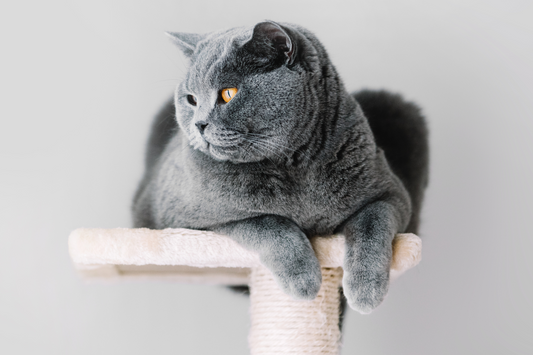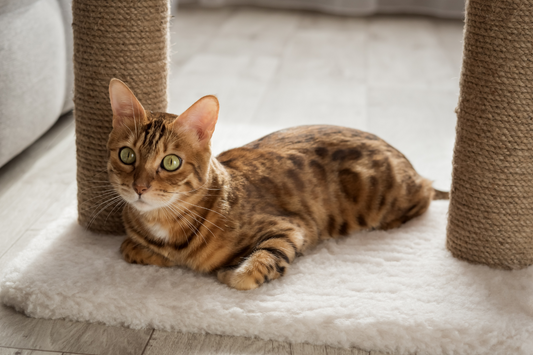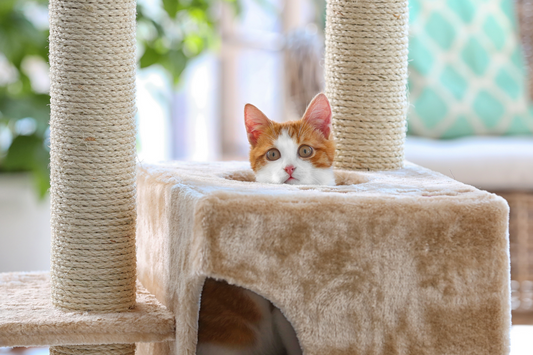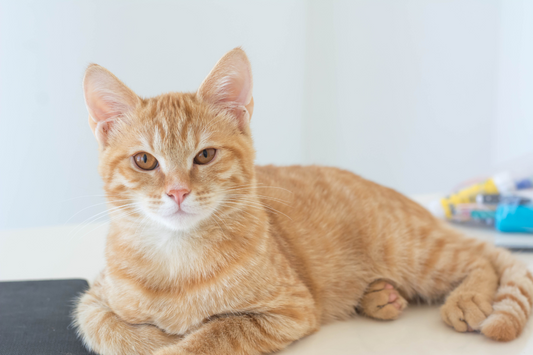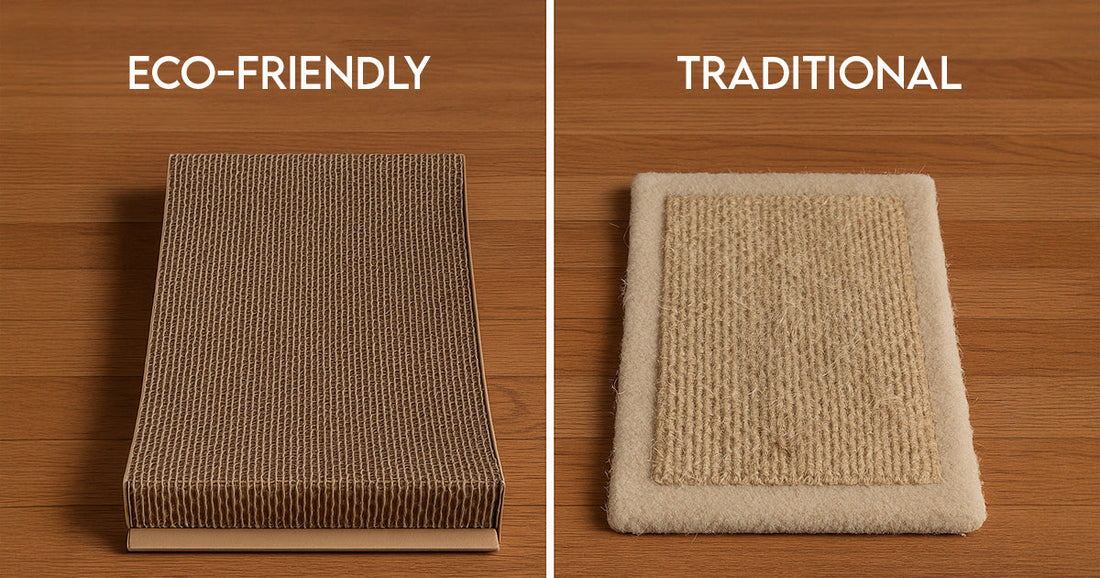
Scratching is a natural behavior for cats. It helps them mark territory, keep their claws healthy, and release stress or energy. To accommodate this instinct, cat owners often invest in scratchers. But with growing environmental concerns, many pet owners are asking: Should I choose an eco-friendly cat scratcher, or stick with traditional options?
This post explores the key differences between eco-friendly and traditional cat scratchers, examining materials, cost, durability, design, and environmental impact. By the end, you’ll have a clearer idea of which type best suits your lifestyle, values, and feline friend.
1. Understanding the Basics: What Are Cat Scratchers Made Of?
Traditional Cat Scratchers
Traditional scratchers typically come in three main forms: carpet-covered posts, sisal rope-wrapped poles, and cardboard pads. Here’s a breakdown:
- Carpet Scratchers: These often mimic home carpeting and appeal to cats who like a softer, textured surface.
- Sisal Rope Scratchers: Known for their durability, sisal-wrapped posts are tough and long-lasting.
- Corrugated Cardboard Pads: Inexpensive and popular, these provide a satisfying scratch but wear out quickly.
Most traditional options are made using synthetic materials, adhesives, and plastic-based components that are not biodegradable.
Eco-Friendly Cat Scratchers
Eco-conscious alternatives aim to minimize environmental impact. They often use:
- Recycled Cardboard: Sustainably sourced and biodegradable.
- Bamboo or Untreated Wood: Fast-growing and renewable.
- Natural Sisal Fabric: Unlike rope, fabric is easier to recycle or compost.
- Non-Toxic Adhesives: Free from harmful chemicals.
Some eco-friendly scratchers are even fully compostable or recyclable after use.
2. Durability and Functionality
Traditional Options
One major selling point of traditional scratchers, especially sisal-wrapped posts and carpeted options, is their durability. They can withstand heavy daily scratching for months or even years. However, once damaged, many cannot be repaired and often end up in the trash.
Corrugated cardboard scratchers, while cheap and widely used, have short lifespans. They shed bits of cardboard, requiring more frequent replacements and cleanup.
Eco-Friendly Options
Durability varies among eco-friendly models. Some recycled cardboard scratchers are surprisingly tough, especially when layered or designed in innovative ways (like honeycomb structures). Bamboo and natural wood scratchers, though less common, are both durable and biodegradable.
The key benefit here is end-of-life management: many eco-friendly options break down naturally or can be safely composted or recycled, making their shorter lifespan less impactful on the environment.
3. Design and Aesthetic Appeal
Traditional Scratchers
Designs range from utilitarian to elaborate cat towers with perches, toys, and built-in beds. While functional, some can be bulky and clash with home décor. Materials like synthetic carpet or brightly dyed rope may not suit minimalist or eco-conscious interiors.
Eco-Friendly Scratchers
Eco-friendly brands often focus on sleek, modern designs that fit contemporary homes. Neutral colors, natural textures, and minimalist shapes are common. You’ll find options like wave-shaped scratch pads, modular furniture-style posts, or recycled cardboard lounges that double as scratchers.
This added aesthetic appeal often makes eco-friendly scratchers more than just pet tools—they become stylish pieces of furniture.
4. Environmental Impact
This is where the biggest difference lies.
Traditional Scratchers
- High Carbon Footprint: Use of plastics, synthetics, and chemical adhesives.
- Non-Biodegradable Waste: Most parts end up in landfills.
- Resource-Intensive: Carpet and glue production consume significant water and energy.
Eco-Friendly Scratchers
- Lower Carbon Footprint: Sustainable materials and manufacturing processes.
- Minimal Waste: Many parts are compostable or recyclable.
- Toxin-Free: Better for indoor air quality and safer for pets.
If you’re aiming to reduce your pet’s environmental pawprint, eco-friendly scratchers clearly lead the way.
5. Cost Considerations
Traditional Options
- Lower Upfront Cost: Budget-friendly options are widely available.
- Frequent Replacement: Cheaper materials mean you’ll likely replace them more often.
Eco-Friendly Options
- Higher Initial Cost: Sustainable materials and ethical production often come at a premium.
- Long-Term Value: Higher quality may reduce frequency of replacement. Plus, the environmental savings could justify the upfront investment.
For example, a traditional cardboard scratcher might cost $10 but need replacing monthly. A $30 eco-friendly version might last three times as long and decompose naturally after use.
6. Health and Safety
Cats love to chew, scratch, and lick their toys. It’s important to consider what they're exposed to.
Traditional Scratchers
Many are made using chemical-laden adhesives, synthetic carpets, or dyes that can be harmful if ingested. Over time, wear and tear may expose inner materials that aren’t pet-safe.
Eco-Friendly Scratchers
These are often designed with pet safety in mind. Non-toxic glues, untreated woods, and chemical-free surfaces reduce the risk of health issues. For households with sensitive pets or health-conscious owners, this can be a deciding factor.
7. Brand Transparency and Ethics
With the rise in conscious consumerism, many buyers now look beyond the product to the company behind it.
Traditional Brands
Large pet supply brands often mass-produce scratchers without clear sourcing or sustainability practices. While affordable and accessible, they may not prioritize environmental or ethical standards.
Eco-Friendly Brands
Many eco-conscious companies highlight their values: cruelty-free testing, fair labor practices, low-waste packaging, and carbon-neutral shipping. Supporting these businesses can align your purchases with your values.
Conclusion: Which One Should You Choose?
Both eco-friendly and traditional cat scratchers serve the essential purpose of keeping your cat healthy and entertained. The best choice depends on your priorities:
- Go Traditional If:
- You're on a tight budget.
- Your cat is very rough on scratchers.
- You need a quick, easy option with wide availability.
- Go Eco-Friendly If:
- You prioritize sustainability and reducing waste.
- You want a non-toxic, stylish, and safe alternative.
- You’re willing to invest more upfront for long-term and ethical benefits.
At the end of the day, your cat will likely be happy with either—so why not choose the one that makes you feel better too?
Pro Tip: No matter which type you choose, placement matters! Place the scratcher where your cat already likes to scratch (e.g., near furniture or favorite nap spots). Encourage use with catnip or treats, and replace it when it shows signs of excessive wear.
Your cat—and the planet—will thank you.
